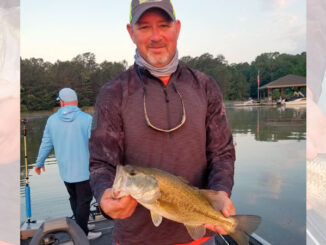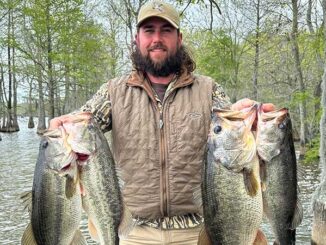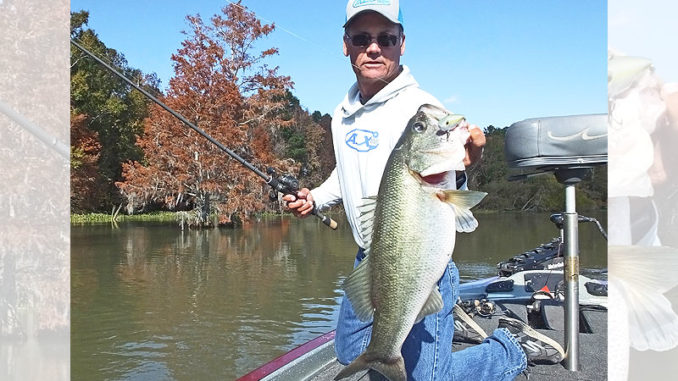
Many anglers wait for March to break out their tackle. But they’re missing out on some great action, especially for the gigantic bass that cruise Lake Moultrie and Lake Marion.
Many anglers wait on March to begin fishing for the Santee Cooper lakes’ huge largemouth bass, but while they’re spooling reels and painting lures, some anglers are already cashing in on the big bass bonanza.
Brett Mitchell, a guide and tournament fisherman, said anglers not fishing in February are missing prime big-bass fishing in shallow water.
“By mid-January and through February, some of the biggest bass of the year are caught,” Mitchell said. “I think the biggest bass in these lakes make their prespawn move early, and right now is the time to catch them.”
Mitchell, 52, from Timmonsville, S.C., has fished Lake Moultrie and Lake Marion most of his life, and his passion for early season fishing is well-founded. The biggest bass of his life, 14 pounds, came from Lake Marion on Feb. 16, 1986.
Mitchell (803-379-7029) fishes both Marion and Moultrie, depending on the best seasonal fishing. He’s developed a game plan for these early season bass. His focus is on water 8 feet and shallower.
“Plenty of huge bass are in this range of water, and on some days, the fattest bass are in the skinniest water,” he said “But only a small percentage of water is going to be productive right now.”
Top areas have three key elements
Mitchell said his top areas have depressions, wood and rocks.
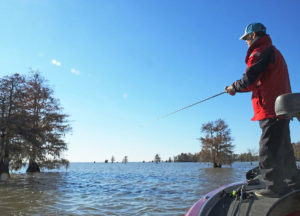
Depressions are found throughout both lakes in the shallow flats, coves or creeks. All depressions are not created equal and no “one-type-is-best” blueprint exists.
“The fish want to be shallow, but they find the deepest shallow water in the area,” he said. “Some depressions may be 6-feet deep, ringed by a shallow flat perhaps 3-feet deep. But depressions much less dramatic in depth change work well, with the depth difference the key.”
Mitchell said one difference maker in productive spots is the availability of forage, with scattered pods of shad excellent. The slightly deeper water is a haven for shad, and the presence of underwater cover such as stumps or brush enhances a specific depression by giving bass an ambush point and Mitchell a defined target.
“Sometimes, I’ll mark shad on the graph, but because they’re usually in small, scattered pods, it can be difficult,” he said. “I key on the presence of loons. If they’re consistently in a specific depression, it’s because they have something to eat.”
Don’t overlook trees this month
Mitchell fishes the entire depression from the edge where the bottom drops slightly and targets any wood in the area. He also looks for bass roaming the depression following shad, so he’ll fish in a grid-like pattern until he finds fish or moves to the next target.
His “homerun” target is a depression with cypress trees along the edge where the flat drops into deeper water, with woody cover and shad in the interior.
“I use multiple lures when working depressions, with twin-bladed spinnerbaits being a favorite. Size varies with the depth fished,” he said. “Lipless and shallow-running crankbaits rank high. I prefer some wind when fishing this type target. But if the water is calm, I’ll often go to soft plastics.”
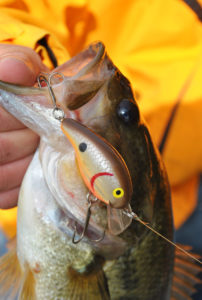
Mitchell said fishing trees is good year-round, but they are often overlooked by anglers in February.
“I prefer trees that are slightly deeper for holding really big bass,” he said. “Trees well back on a flat in 1½ feet of water are usually bypassed until March and April. I like fishing trees in water that’s 21/2 feet deep or deeper in February. That’s not a magic number, but I’ve found fishing trees in water that deep produces more big fish.”
Careful with the casting
“Casting accuracy is directly related to catching big fish on trees at this time of the year,” he said. “If a big bass is holding tight and wants a lure 2 inches from a tree and you get it to 3 inches, you may not get the bite. Work on your casting until you can hit a tiny target.”
Mitchell isolates trees over clumps in February. And he’ll work any woody cover with two different type baits before moving. A spinnerbait and a soft-plastic lure are good examples.
Lure colors will vary with water conditions, with bright colors such as chartreuse in dingy water and natural shad patterns when the water is clear.
A variety of lures come into play this month
“The bright ‘clown’ colors such as chartreuse and orange work well for me in dingy water conditions,” he said. “Also, the solid color patterns on crankbaits are best in dirty water, and the translucent lures in basic, shad patterns are my choice in clear water.”
Mitchell also targets rocks, and his idea of fishing rocks is working areas with a combination of rocks and current flow creating eddies where bass can hold and ambush prey.
“The Diversion Canal area is a prime place to find these type situations,” he said. “These features form a reliable early season pattern,” he said. “I’ll generally fish spinnerbaits, lipless crankbaits and umbrella rigs in this situation. I’ll usually find drops that fall from 3 feet down to 6 feet or deeper, and these rocky edgelines are big fish magnets.”
Mitchell said patience and perseverance are important and to remember this is the time of year to catch a fish of a lifetime.
“Reasonable expectations on numbers of bites are necessary, but February is big-bass time,” he said. “We don’t catch numbers compared to later in the spring, but the big-fish potential is off the charts. Any cast can produce an 8-pound or larger fish on Marion or Moultrie, sometimes much larger.”
Sampling data confirms Santee Cooper is ‘big-bass’ destination
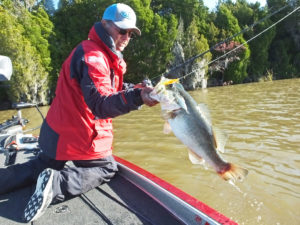
Big bass on the Santee Cooper lakes are not just a fisherman’s dream, they are backed by scientific fisheries data. Levi Kaczka, a biologist with the S.C. Department of Natural Resources, said the past two springs of bass sampling confirm that the lakes are classified as “big-bass” systems.
Kaczka said this designation refers to the proportional or relative stock density metric, which assigns a qualitative descriptor such as “big bass” to the sampled fishery. The descriptor is based on the proportion of big bass in the sample.
He said the complex forage base in Santee Cooper is one reason bass are doing so well in both lakes.
“Management strategies that lead to a ‘big-bass’ designation on a farm pond may prevent the abundance of large panfish due to bass predation,” he said. “But the complexity of the food web and availability of alternative forage resources on the Santee Cooper lakes allows the system to achieve a “big bass” designation while also providing catches of large sized panfish.
“The relative abundance of these size fish in our samples, as well as visual observations of spawning fish, nests and recently hatched fry, indicate successful reproduction and recruitment for largemouth bass in the system as well, leading to an overall stable fishery.”
Umbrella rigs highly effective for winter bass
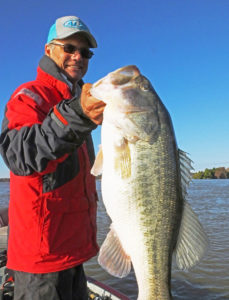
Brett Mitchell’s arsenal of lures for winter fishing is extensive but the umbrella rig, aka Alabama rig is one he works into his presentation on a daily basis.
“The umbrella rig is overlooked on these lakes at this time of year,” he said. “I use this rig every day when fishing the early season. I often find when conditions are right for the crankbaits and spinnerbaits to produce, but they’re not, the umbrella rig will trigger the bite.”
Mitchell said the umbrella rig is ideal for fishing depressions, rocks, ledges and funnels.
“The rig seems to trigger a competitive response to what appears to be a small school of baitfish moving by,” he said. “This is a big-bass bait this time of year. Some days, I’ll work it all day.”
Mitchell is selective where he uses the rig because of its expense, but when he identifies a pattern, he’ll quickly fish multiple similar situations on a “milk run’”with high expectations of a fish or two at each spot.
His umbrella rig is one he describes as medium-size, basic rig with 1/8- or 1/4-ounce heads based on water depth fished. If the water is 4 feet or less, he uses the 1/8-ounce and the ¼-ounce for deeper water.
“I like the Keitech Swing Impact 4-inch worms in the Sight Flash pattern, but again, water color will impact my choice,” he said.
Destination Information
- HOW TO GET THERE — Lake Marion and Lake Moultrie are just north of I-26 between Charleston and Columbia, with I-95 crossing Lake Marion, providing access to fishing camps on both sides of the lakes. The Diversion Canal connects the two lakes and is a prime area for fishing either lake with numerous fishing camps available for lodging, boat access and tackle supplies. For complete details visit www.santeecoopercountry.org.
- WHEN TO GO — February and March are prime months to catch trophy largemouth bass on the Santee Cooper lakes.
- BEST TECHNIQUES — Find deeper depressions on relatively shallow flats. Try to locate wooden or rocky cover. Fish a shallow-running crankbait, lipless crankbait, soft plastics or an umbrella rig, aka Alabama rig.
- FISHING INFO/GUIDES — Brett MItchell (803-379-7029); Santee Cooper Country, 800-227-8510, www.santeecoopercountry.org. See also Guides & Charters in Classifieds.
- ACCOMMODATIONS — Blacks Camp, 843-753-2231; Santee Cooper Country, 800-227-8510, www.santeecoopercountry.org.
- MAPS — Fishing Hotspots, 800-338-5957; Kingfisher Maps, 800-326-0257, www.kfmaps.com; DeLorme’s South Carolina Atlas & Gazetteer, 207-846-7000, www.delorme.com.

